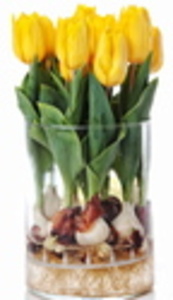Forcing bulbs is something gardeners do in the winter in Maine because they are bored. It is also nice to have some flowers blooming in your house in winter just at the time you really are looking forward to getting back in the garden.
The easiest bulbs to grow are paperwhite narcissus, because the bulbs do not have to be chilled to produce flowers, can be grown in almost any medium with some moisture and bloom quickly.
You simply put the bulbs – which are available at garden centers, hardware stores, box stores and some grocery stores – into a pot or a vase, cover them with planting mix, pebbles or colored glass, add some water, and in four to six weeks you will have some fragrant blossoms.
The fragrance is strong and unique. While many people love it, others find it repugnant.
If you are among that sizable minority, there are many other choices, but these have to be chilled, and they take longer.
In Victorian times the favorite bulb to force was hyacinth, another highly aromatic flower.
People used hyacinth glasses for forcing bulbs, which had a large round area at the bottom, a small neck and another larger area on the top to hold the bulb.
You fill the vase with water so that when you put the bulb on top it is close to but not touching the water.
Put it in an area that’s cold – 48 degrees Fahrenheit or lower but not freezing – for at least eight weeks. Then keep it in an area of your home with subdued lighting and temperatures of about 60 degrees.
In a few weeks, you will get blossoms.
When Nancy forces bulbs, she does it in plant pots using soil, because we have plenty of both pots and soil.
You can do pots all of one flower – daffodils, tulips, narcissus or whatever you want – or you can mix them, which will extend the bloom time in each pot.
Put the bulbs close together without touching, just below the soil surface.
Again, you have to put them in a cold space that will not freeze.
Options include an unheated garage, a bulkhead in the cellar, an unheated attic or even the refrigerator.
Old House Gardens, a bulb company in Michigan, recommends putting them outside in the garden.
You dig a trench a couple of feet deep and cover all of the pots with leaves, keeping the leaves moist, and the bulbs will stay cold but still not freeze.
After the eight weeks, you bring the pots in the house, where, again, you want them in temperatures around 60 degrees.
Keep them watered and eventually you will have early flower blossoms.
In an ideal world, you would have begun cooling these bulbs in early November.
But if you do it now, you will have flowers available in March and April, before much is happening outside.
Once the pots are done blossoming, you are not done with them.
When the outdoor gardens are ready to work, separate the bulbs and plant them.
You do not want to plant them as closely together in the garden as you do in the pots, so they will have a chance to spread in future years.
By blooming inside, the bulbs have used up all of their stored energy.
But if they get a good spot in your garden, they should grow, and eventually – not necessarily the first year you plant them, but within two or three years – they will start blooming outside.
You can’t do this with the paperwhites because they won’t survive outside in a Maine winter, but you can “recycle” most of your forced bulbs.
And, looking ahead, you may want to try planting your Easter lilies and other spring plants outside.
They may or may not live through one of our winters, but gardeners always want to give a plant a chance to live.
Tom Atwell has been writing the Maine Gardener column since 2004. He is a freelance writer gardening in Cape Elizabeth and can be contacted at 767-2297 or at:
tomatwell@me.com
Send questions/comments to the editors.



Success. Please wait for the page to reload. If the page does not reload within 5 seconds, please refresh the page.
Enter your email and password to access comments.
Hi, to comment on stories you must . This profile is in addition to your subscription and website login.
Already have a commenting profile? .
Invalid username/password.
Please check your email to confirm and complete your registration.
Only subscribers are eligible to post comments. Please subscribe or login first for digital access. Here’s why.
Use the form below to reset your password. When you've submitted your account email, we will send an email with a reset code.